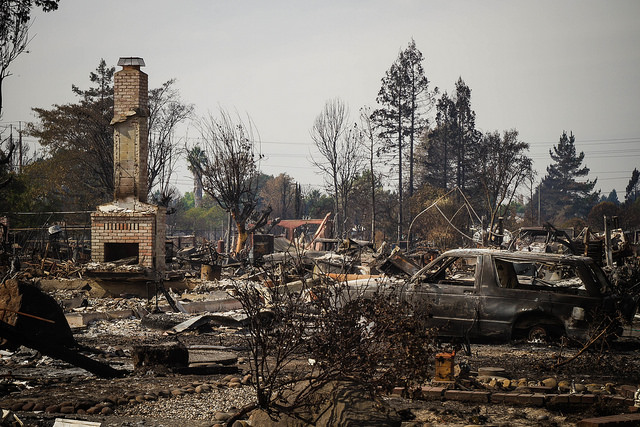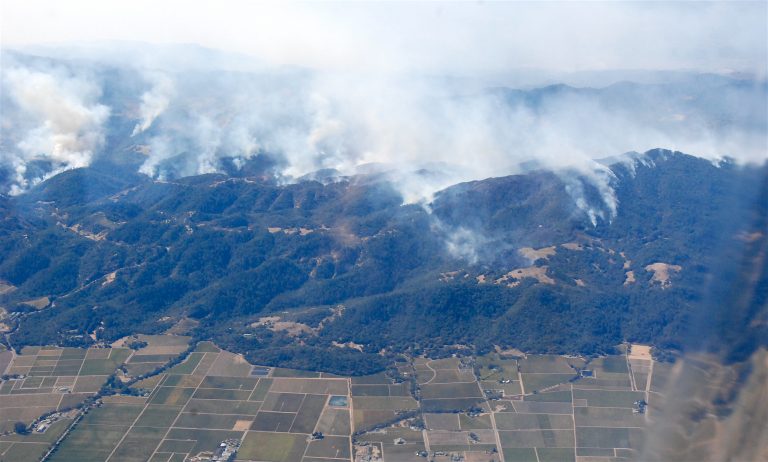Wine Insurance - a Primer
After the smoke has cleared on the devastating fires in the Napa and Sonoma/Northern California wine country, residents are presented with the task of sifting through the ash and debris to find out what might be lost and what might be saved in the aftermath of these deadly fires. In addition to the residential destruction, many businesses suffered a great deal of damage. You may be wondering what is going to happen to the wineries damaged or destroyed in these fires. Were they protected by insurance? How does winery insurance even work?
In the big picture sense, there are two types of insurance available for wineries: crop insurance, and winery insurance.
Grape/Crop Insurance
Scholars estimate this type of insurance likely started soon after the early successes of the California wine industry or in the late 19th century, sometime after crop insurance became available for other crops. Basically, wine grape insurance exists to protect the grower against financial losses due to crop failure.
In terms of policy conditions and rates, all are set by the Federal Crisis Inquiry Commission (FCIC) regardless of state, though currently wine grape insurance is only available in states that produce enough to incorporate them into the National Agricultural Statistics Service (NASS) online database. If you’re state does not offer FCIC wine grape insurance, you can still apply for crop insurance with your agent based on policies of neighboring states that do offer this insurance.
In order to be eligible for wine grape insurance, your crop must meet two criteria: 1) for native varieties, the vines must be in the ground for at least 4 years and: 2) for Vitis vinifera, the vines must be in the ground for at least 5 years before they are eligible for crop insurance coverage.
Winery insurance
In addition to crop insurance, if you are making wine from grapes you also need winery-specific insurance, which can cover a wide range of things depending upon who you use for an insurance agent and what sorts of options they offer.
First, there is coverage for the actual property. This covers things like damage to buildings, winemaking equipment, inventory, and stock.
In addition to general property coverage, wineries can also add on more specific coverage that can help when other problems might arise at the winery, including contract cancellation, tank collapse, tank leakage, and mobile equipment. Wineries can also get insurance coverage for wine in storage and when in transit, so even after the grapes are harvested and the wine is made, it can still be covered in case of losses occurring during the storage process or even when moving your wine from one place to another. There is even coverage for equipment maintenance/repair, so if a piece of winemaking equipment breaks down, the winery can submit a claim to repair the faulty device.
In addition, wineries can insure against possible contamination or spoilage. For example, if the power goes out for a significant chunk of time and critical pieces of winemaking equipment go offline—like the temperature controls on a tank of fermenting wine--if the winery has contamination/spoilage coverage, then they might be able to receive an insurance pay-out for any wine that has been contaminated due to uncontrolled conditions during that power outage. This is likely going to apply to many wineries in the Napa/Sonoma area after the wildfires, as power was off for a time and no one was allowed back in for quite some time to address the issue when it needed to be addressed.
Finally, wineries also can get liability insurance for visitors to the winery as well as liquor-specific liability coverage. If someone slips and falls during a winery visit, or if there is any damage to the winery by a person under the influence, liability coverage is a necessity.
In addition to more common coverage options just listed, there are even more specialized coverage options available for wineries. These options include (but aren’t limited to): commercial car insurance, crime coverage, workers compensation, cyber liability, chemical drift or pollution liability, product recall coverage, and employment practices liability.
Outlooks for wineries damaged in the Northern California wine country
Since it is still relatively soon after the fires have gone out, there are many insurance claims still waiting to be filed in Northern California, so exact numbers of damage and insurance pay-outs is not possible at this time. Current predictions on economic losses from the wildfires range from $3 to $6 billion, and that doesn’t even include agricultural/winery losses. In a recent Reuters article (see below), Tom Pagagno, the head of the vineyard insurance practice at Aon Plc., stated that gaps in coverage and the large number of claims being filed all at the same time will be problematic for many wineries, particular those smaller wineries with fewer resources. The relative ease in which a winery can recover financially from these devastating fires could come down to what type of coverage they had purchased prior to this disaster. Some wineries will likely find themselves in more financial trouble than others, making the recovery processes longer and more expensive than would be desired.
Speaking directly with a couple of winemakers in the area, it is still too early to tell what sort of insurance claims will be made at affected wineries, and details about potential claims are currently unavailable.
Overall, the relative losses for the Napa and Sonoma wine industry as a whole is smaller than what could have been. According to a CBS interview with Lewis Perdue (Wine Industry Insight) (see below), somewhere between 30 and 60 wineries have suffered some form of damage, ranging from total destruction to minor landscaping and cosmetic damage. In terms of the overall industry, Perdue said that with close to 900 wineries located in Napa and Sonoma counties alone, the damage to the 30-60 in this fire is “serious, but it’s not a killer blow to the industry”.
In the wake of these disasters, it’s important for everyone to keep visiting Napa and Sonoma wine country. The majority wineries in the area are OPEN and eager for our business. According to contacts at V. Sattui Winery in St. Helena, “we need visitors more than ever to support the rebuilding our community and by putting everyone back to work by visiting our wineries, drinking our wines, staying in our hotels and eating in our restaurants.“ While it’ll be an emotional and financial rollercoaster for many, wine country will recover and be as strong as it ever was.
Sources:
O’Boyle, E.J. 2017. Insurance for growers of wine grapes. American Association of Wine Economists Working Paper No. 219: Business.
Trusted Choice Independent Insurance Agents. Winery Insurance. https://www.trustedchoice.com/n/31/winery-insurance/ Accessed online 10/23/17.
CBS This Morning Wine Industry Damage Coverage. http://www.cbs.com/shows/cbs_this_morning/video/MQNfwJOZJYymWnx9IWC_i3EgFKRVYCJM/how-will-wildfire-damage-to-california-vineyards-impact-industry-/ Video viewed 10/23/17.
Baryln, S. Insurance payouts may not cover all wildfire damage for California wineries. Reuters. https://www.reuters.com/article/us-california-fire-insurance/insurance-payouts-may-not-cover-all-wildfire-damage-for-california-wineries-idUSKBN1CM171 Accessed online 10/23/17.
Economic losses from wine country wildfires at up to $8bn (Intelligent Insurer. Accessed 10/30/17)
Insured losses from deadly California wildfires could hit $3 billion (Reuters. Accessed 10/30/17)
Editor's note: For those interested in helping with wildfire recovery efforts, here is a link from Grub Street detailing where to donate to several California wildfire charities, volunteer in disaster recovery and support businesses outside of California who are working to benefit fire victims.



